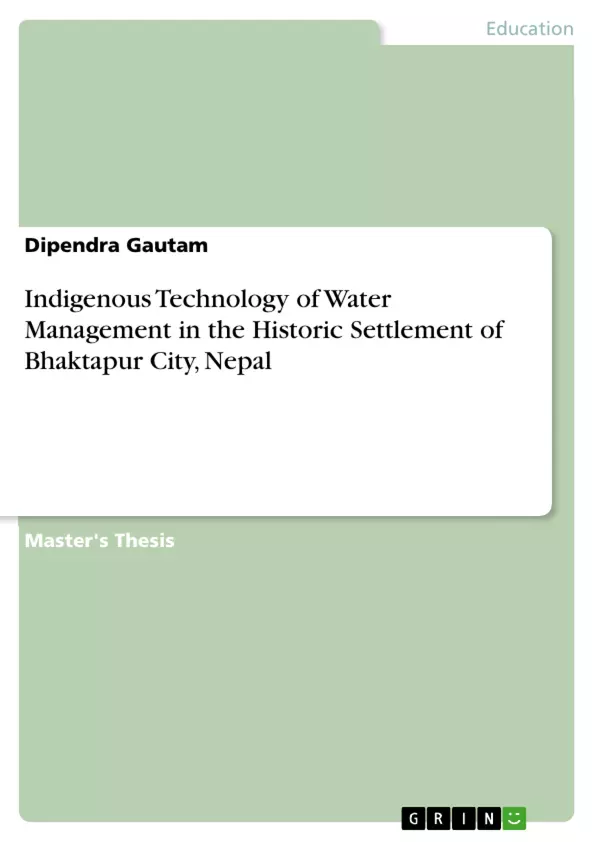The assessment of indigenous technology practiced in the historic settlement of Bhaktapur city, Nepal has concluded the indigenous technology to be sound and efficient too. Water management is a prime challenge for a city to be sustainable, so the technology behind the effective water management in the city has been researched. It is found that, the indigenous technology of water management is also a scientific approach too.
Inhaltsverzeichnis (Table of Contents)
- Abstract
- Chapter 1: Introduction
- Chapter 2: Literature Review
- Chapter 3: Methodology
- Chapter 4: Results and Discussion
- Chapter 5: Conclusion (This section is excluded per instructions)
Zielsetzung und Themenschwerpunkte (Objectives and Key Themes)
This dissertation aims to investigate the indigenous technology of water management in the historic settlement of Bhaktapur City, Nepal. It explores the traditional methods of water resource management, their effectiveness, and the challenges they face in the contemporary context. The research juxtaposes traditional practices with modern approaches to water management.
- Indigenous water management technologies in Bhaktapur City.
- The cultural and historical significance of water sources.
- The impact of anthropogenic activities on traditional water systems.
- Comparison of traditional and modern water management techniques.
- The sustainability of indigenous water management practices.
Zusammenfassung der Kapitel (Chapter Summaries)
Chapter 1: Introduction: This chapter introduces the topic of indigenous water management technology in Bhaktapur City. It establishes the context of the research, highlighting the significance of understanding traditional water systems and their relevance in the modern era. The chapter also provides a brief overview of the research methodology and the structure of the dissertation. It lays the groundwork for the subsequent chapters by introducing the key concepts and questions that will be addressed throughout the study.
Chapter 2: Literature Review: This chapter examines existing literature on indigenous water management technologies, focusing on similar studies and relevant theoretical frameworks. It explores the historical context of water management in Bhaktapur and reviews scholarly work on traditional water systems in Nepal and other regions. The chapter establishes a theoretical foundation for the research and positions the current study within the broader body of knowledge.
Chapter 3: Methodology: This chapter details the research methods employed in the study. It describes the research design, including the data collection techniques used (such as key informant interviews and field observations). The chapter explains the selection of the study area and the rationale behind choosing specific water structures for analysis. It also addresses limitations of the methodology and discusses the strategies used to ensure the validity and reliability of the research findings.
Chapter 4: Results and Discussion: This chapter presents the findings of the field study, analyzing the construction, supply, drainage, and conveyance of water resources in Bhaktapur City. It focuses on the characteristics of Hitis, Tuns, and Pukhus, examining their design, functionality, and the sociocultural practices associated with them. The chapter compares traditional and modern water management approaches, highlighting the strengths and weaknesses of each. The discussion section analyzes the impact of anthropogenic activities and the depletion of traditional water sources.
Schlüsselwörter (Keywords)
Indigenous technology, water management, Bhaktapur City, Nepal, Hitis, Tuns, Pukhus, traditional water systems, anthropogenic activities, sustainability, cultural heritage.
Frequently Asked Questions: A Comprehensive Language Preview of Indigenous Water Management in Bhaktapur City, Nepal
What is the main topic of this dissertation preview?
This preview summarizes a dissertation investigating indigenous water management technologies in Bhaktapur City, Nepal. It explores traditional methods, their effectiveness, and the challenges they face in the contemporary context, comparing them to modern approaches.
What does the Table of Contents include?
The table of contents includes an abstract, chapters on introduction, literature review, methodology, results and discussion, and a conclusion (though the conclusion is excluded from this preview).
What are the key objectives and themes of the research?
The research aims to understand indigenous water management technologies in Bhaktapur City, their cultural significance, the impact of human activities, and a comparison with modern techniques, ultimately assessing the sustainability of traditional practices. Key themes include the analysis of Hitis, Tuns, and Pukhus – traditional water structures.
What is covered in each chapter (as summarized in the preview)?
Chapter 1 (Introduction): Introduces the topic, establishes context, and outlines the research methodology and structure. Chapter 2 (Literature Review): Examines existing literature on indigenous water management, focusing on relevant studies and theoretical frameworks in Nepal and other regions. Chapter 3 (Methodology): Details the research methods, including data collection techniques (interviews, observations), study area selection, and strategies to ensure validity and reliability. Chapter 4 (Results and Discussion): Presents findings on the construction, supply, drainage, and conveyance of water resources in Bhaktapur City, analyzing Hitis, Tuns, and Pukhus, and comparing traditional and modern approaches. It also discusses the impact of human activities and depletion of water sources.
What are the key words associated with this research?
The key words are: Indigenous technology, water management, Bhaktapur City, Nepal, Hitis, Tuns, Pukhus, traditional water systems, anthropogenic activities, sustainability, and cultural heritage.
What types of traditional water systems are discussed?
The dissertation focuses on Hitis, Tuns, and Pukhus – specific traditional water structures found in Bhaktapur City.
What is the overall approach of this research?
The research takes a comparative approach, juxtaposing traditional indigenous water management techniques with modern methods, analyzing their effectiveness and sustainability within the historical and contemporary context of Bhaktapur City.
- Citation du texte
- Dipendra Gautam (Auteur), 2013, Indigenous Technology of Water Management in the Historic Settlement of Bhaktapur City, Nepal, Munich, GRIN Verlag, https://www.grin.com/document/232888



